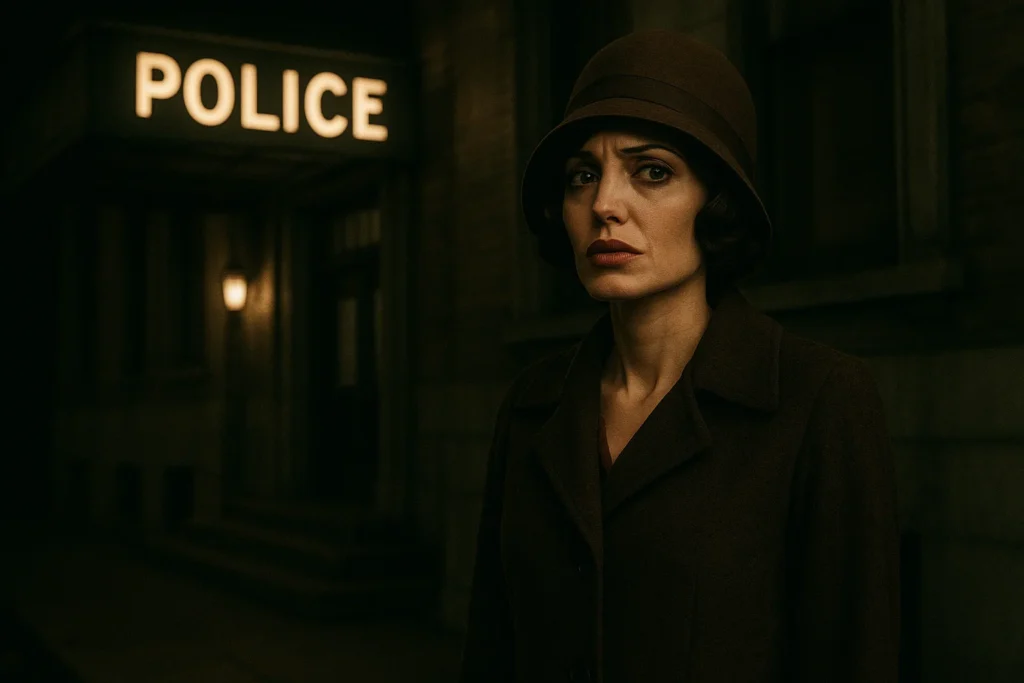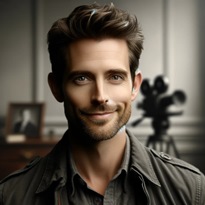
So grab your coffee, movie lover let’s walk through what really happened behind this dark masterpiece.
The Heart of the Story Christine Collins and Her Missing Son
It all begins in Los Angeles, 1928. Christine Collins, a single mother and telephone supervisor, says goodbye to her 9-year-old son, Walter, one ordinary morning. By evening, he’s gone.
What follows sounds like something straight from a noir thriller. Police investigations drag on. Leads fade. Five months later, the LAPD proudly declares success: they’ve “found” Walter Collins. Cameras flash, headlines praise the department. Only one problem Christine looks at the boy and says, “That’s not my son.”
The police refuse to listen. To them, she’s an ungrateful mother embarrassing the department. To Christine, the world has gone mad. This horrifying gaslight forms the emotional engine of Changeling (2008) and yes, this part of the story is 100% real.
“Is The Changeling 1980 Based on a True Story?” Not That One
Before diving deeper, quick note: there’s also a 1980 Canadian horror movie called The Changeling a ghost story about a haunted mansion. Same title, completely different tale.
Clint Eastwood’s Changeling (2008) is the true-crime drama based on the real case of Christine Collins and the Wineville Chicken Coop Murders.
When Lies Became Law The LAPD Cover-Up
Back in the late 1920s, the Los Angeles Police Department was under fire for corruption. They needed good publicity. So when a runaway boy in Illinois claimed to be Walter Collins, they jumped on it. The child’s name was actually Arthur Hutchins Jr., a 12-year-old drifter who just wanted a free trip to Hollywood.
Christine knew instantly the boy was a stranger. She showed the police proof her son was taller, his teeth were different, and the boy didn’t recognize his own dog. But Captain J. J. Jones refused to admit the department’s mistake.
He told her to “try the boy out for a few weeks.” Imagine being told to test-drive a child while your real son is missing.
When Christine kept protesting, Jones had her thrown into the Los Angeles County Psychopathic Ward. That’s right the victim became the accused. The film shows this moment with chilling accuracy: Angelina Jolie’s quiet strength facing a wall of male authority.
Angelina Jolie’s Transformation as Christine Collins
Jolie doesn’t just act she embodies heartbreak. Her restrained grief and fierce determination anchor the film. Critics praised her ability to project both fragility and defiance, making Christine’s real pain feel immediate.
Eastwood shot the movie with muted sepia tones and natural light, echoing the 1920s photography style. Every frame looks like a faded memory you can’t shake.
Jolie later said in interviews that she accepted the role because it was “more than a film it was a story about truth and courage.” She even visited the real Collins’ neighborhood archives to understand her subject’s life.
The Wineville Chicken Coop Murders The Case Behind the Case
While Christine fought the police, a far darker story unfolded 50 miles east of Los Angeles in a town once called Wineville (now Mira Loma).
A Canadian immigrant named Gordon Stewart Northcott ran a small chicken farm there with help from his teenage nephew, Sanford Clark.
In 1928, Sanford’s sister became suspicious after his letters sounded strange. She contacted authorities. What they discovered turned the missing-child case into one of the most horrifying murder investigations in California history.
Police unearthed evidence of multiple child kidnappings and killings, including bones, bloody tools, and personal items belonging to missing boys one possibly Walter Collins.
Northcott confessed to some murders but denied others. The evidence was so disturbing that newspapers couldn’t print full details.
This is the true crime that Eastwood’s film threads into Christine’s emotional journey her search for truth running parallel to the exposure of a serial killer.
Justice in a Broken System
Christine’s release from the psych ward came only after Reverend Gustav Briegleb, a crusading radio preacher, championed her case. He publicly condemned the LAPD’s treatment of her and demanded justice.
In 1930, Northcott was hanged for his crimes at San Quentin Prison. Before his execution, he taunted Christine by claiming to know the truth about Walter, then retracting it at the last moment.
To this day, Walter Collins’s body was never found. Christine never stopped searching.
Her quiet resilience led to a reform movement that changed how missing-person cases were handled in Los Angeles. That’s the bittersweet heart of Changeling a mother’s fight not just for her son, but for truth itself.
Clint Eastwood’s Direction Restraint Over Gore
Eastwood could have leaned into sensationalism, but he didn’t. Instead, he built tension through atmosphere the clack of telegraph machines, the echo of footsteps in a police hallway, the silence of an empty child’s room.
It’s storytelling that breathes.
His decision to use long, patient takes allows the viewer to sit inside Christine’s helplessness. The production design captures 1920s Los Angeles with eerie precision from streetcars to switchboards a living city shadowed by corruption.
What Is The Changeling About With Angelina Jolie?
At its core, the movie isn’t just about a missing child. It’s about truth versus authority, a woman versus a system, and how grief turns into activism.
Angelina Jolie’s Christine is the embodiment of moral clarity. Even when every door closes, she refuses to bend. In an era when women were dismissed, her voice forced a city to listen.
The film draws power from that emotional realism. You don’t watch Changeling; you feel it tightening around your chest.
What Happened to Christine Collins After the Case?
Historical records show that Christine lived a quiet life afterward, still believing Walter might have survived. She filed numerous appeals, wrote letters to governors, and never stopped attending hearings connected to Northcott’s crimes.
She died in 1964, never knowing what truly happened to her son. Yet her persistence forced the LAPD to reform policies about involuntary institutionalization and missing-person investigations a legacy of courage carved in grief.
The Boy Who Claimed to Be Walter Collins
Let’s clear this up because it’s one of the wildest details of the case. The imposter, Arthur Hutchins Jr., later admitted he pretended to be Walter to get to Hollywood and meet his favorite cowboy star, Tom Mix.
After the lie was exposed, he publicly apologized to Christine. But by then, the damage and trauma were irreversible.
This subplot adds an eerie layer to Changeling: truth becomes stranger than fiction. The police weren’t fooled they simply refused to admit they were wrong.
Cinematic Legacy Why the Film Still Matters
Changeling earned three Academy Award nominations Best Actress (Angelina Jolie), Best Cinematography, and Best Art Direction. But more than accolades, the film remains a testament to moral courage.
Today, it sits among Eastwood’s most underrated works. Critics often compare it to Mystic River for its emotional depth and to L.A. Confidential for its atmospheric crime storytelling.
What sets Changeling apart is its refusal to offer easy closure because real life rarely does.
Filming the Past Attention to Detail
Eastwood’s crew rebuilt entire 1920s streets in downtown Los Angeles. Vintage trolleys, authentic newspapers, even the telephone switchboard room were reconstructed from archives.
Cinematographer Tom Stern used a desaturated color palette and soft contrast lenses to mirror photographs of the era, giving the movie that dreamy, melancholic glow.
Angelina Jolie wore replicas of Christine’s real outfits the cloche hat, the trench coat, the simple heels every piece reinforcing her identity as an ordinary woman trapped in an extraordinary nightmare.
Critical Reception From Cannes to Home Screens
When Changeling premiered at the Cannes Film Festival 2008, it received a 10-minute standing ovation. Critics called it “hauntingly beautiful” and “a film that restores faith in serious storytelling.”
Jolie’s performance was widely seen as one of her best raw, restrained, unforgettable. Roger Ebert praised Eastwood’s direction for “letting the horror of truth speak louder than any scream.”
The movie didn’t break box-office records, but it earned long-term respect from both cinephiles and historians a rare bridge between cinema and social commentary.
Themes That Still Echo Today
Changeling speaks to anyone who’s ever been dismissed, silenced, or doubted. It shows how systems built to protect can sometimes destroy the people they serve.
Nearly a century later, its message still lands: truth matters, and courage has a price.
Behind the Scenes Eastwood’s Approach
Eastwood reportedly shot the film in under 40 days, keeping production lean to maintain emotional focus. He rarely rehearsed scenes, preferring spontaneous takes that kept performances authentic.
Angelina Jolie described him as “the calmest director I’ve ever worked with he trusts his actors completely.”
That trust is why Changeling feels so grounded you’re watching real emotions unfold, not rehearsed dramatics.
Why the Title “Changeling”?
The word “changeling” traditionally means a child secretly switched for another by fairies or spirits a folklore metaphor for loss and deception.
In the film, it’s literal and symbolic: Christine’s real child is replaced by an imposter, and her world is twisted by lies.
It’s one of the most fitting titles in modern cinema simple, eerie, and unforgettable.
What Viewers Take Away
By the end, Changeling doesn’t give the comfort of closure. Instead, it leaves you thinking about the real Christine Collins walking home under streetlights, still hoping.
That quiet, unresolved ache that’s what makes the film powerful.
Movies often dramatize reality. Changeling honors it.
Final Reflection Truth as Cinema
The Changeling Film True Story is a haunting reminder that truth can be stranger, and crueler, than fiction.
Clint Eastwood turned a nearly forgotten 1920s case into a timeless story about human resilience.
Angelina Jolie turned a mother’s grief into a symbol of courage.
And somewhere in Los Angeles, Christine Collins’s spirit still whispers: Never stop fighting for the truth.

I am Jeremy Jahns – Your Cinematic Explorer
Immerse in movie reviews, Hollywood insights, and behind-the-scenes stories.